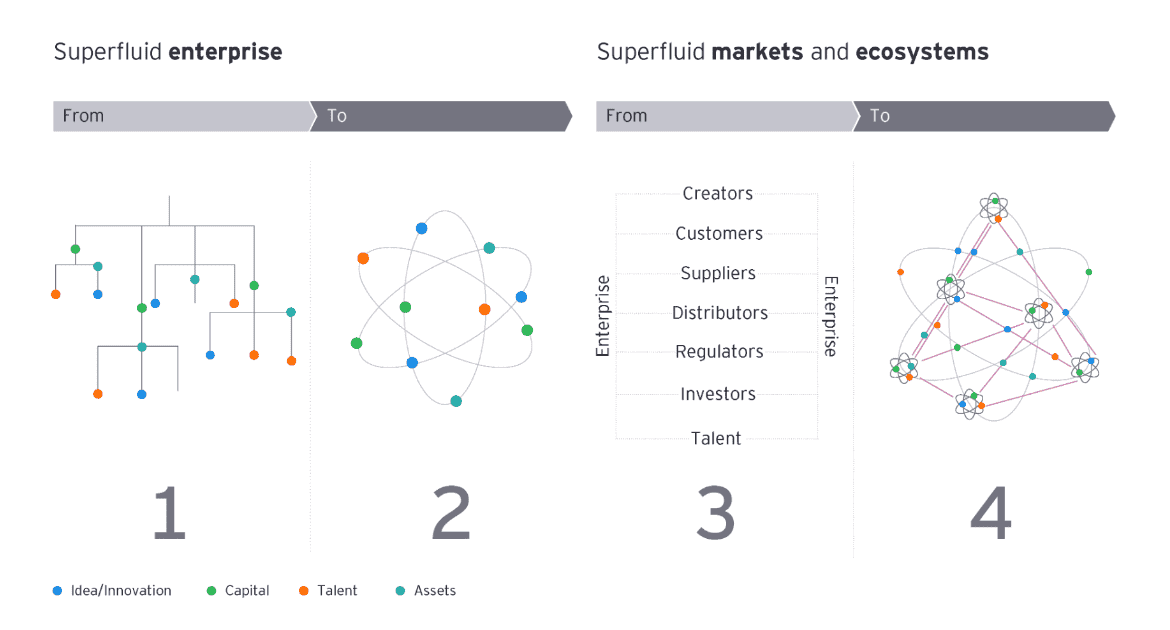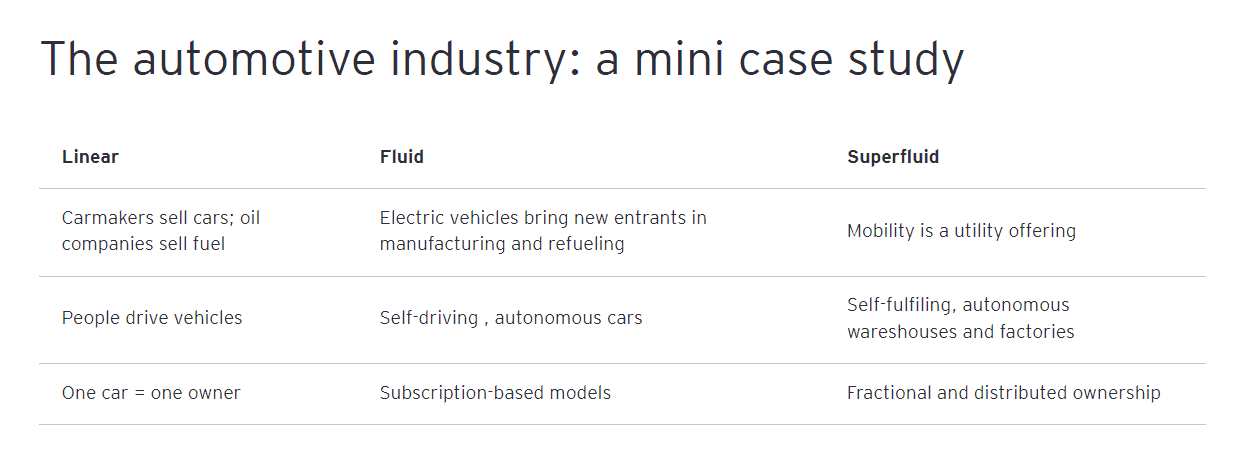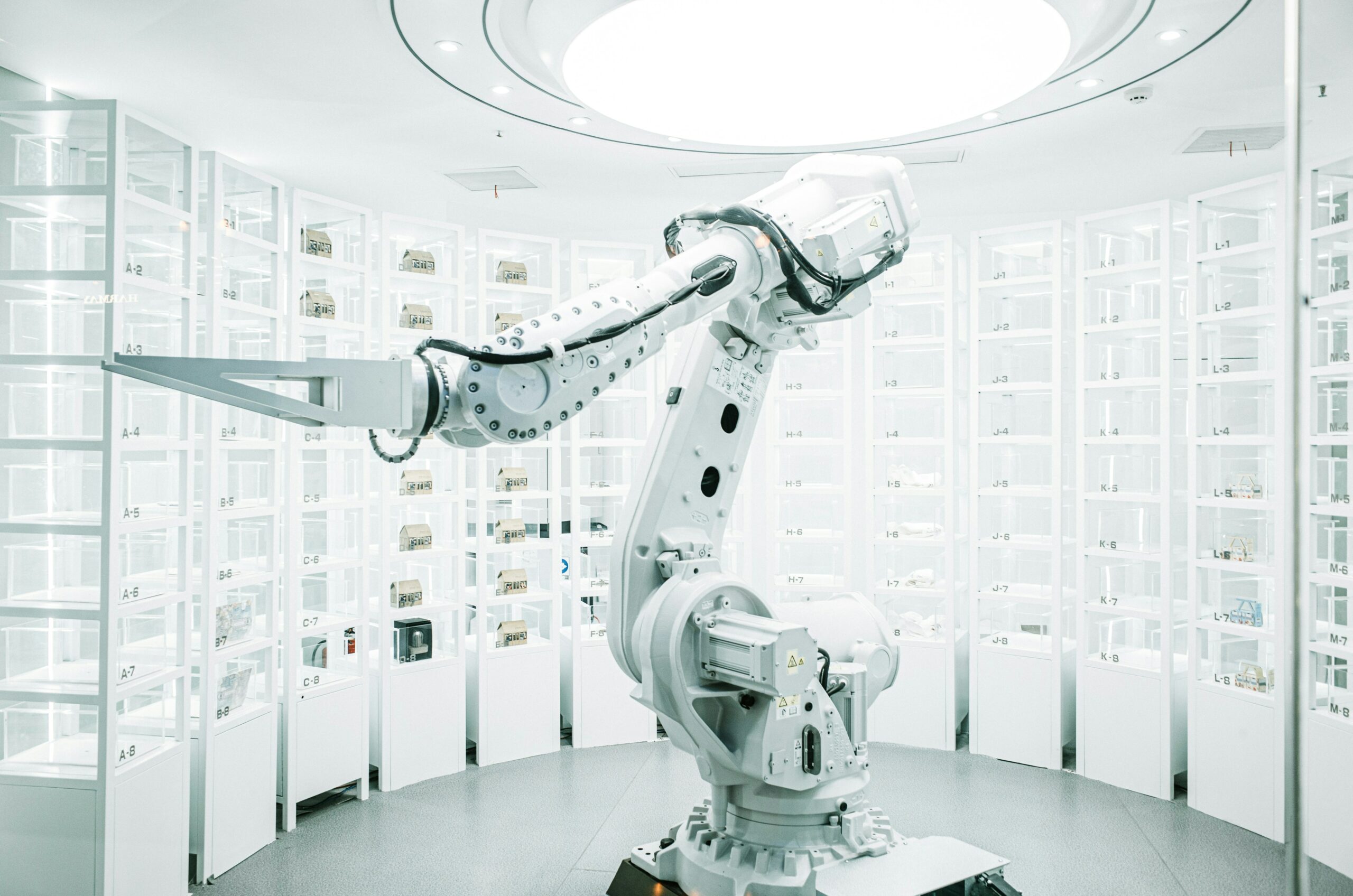Organisations must change how they work to reduce operational friction and connect disparate resources and ideas to unlock value and drive growth.
- Superfluid organisations defy traditional laws of organisation, using emerging technologies and decentralised structures to reduce operational friction.
- To achieve superfluidity, businesses should embrace GenAI and Web3, breaking down silos and enabling decentralised decision-making.
- Leadership roles and activities must undergo a transformation to enable and support superfluidity in the organisation.
It’s time for a new operating model: One that anticipates and responds to the growing needs of the full ecosystem of people and keeps the organisation connected in real-time. From the workforce, to customers, to suppliers and beyond, there is an opportunity to build an intelligent and fluid model, putting the precious resource of humans at the heart of the future equation.
Most companies react to these increasing demands by embarking on efforts to deploy myriad technology advances and data-driven strategies, only to find their operating model and hierarchical organisational structures are not prepared to adapt to real-time decision-making or provide aligned incentives as these transformations are undertaken. As a result, most efforts struggle with issues around people — such as empowerment and skills alignment — structure, governance and ultimately the ability to realize the potential value of these technological innovations.
There is no question that there are real opportunities to make smarter decisions and create value with the help of cutting-edge technologies. But most businesses, afraid to let go of familiar processes and structures, aren’t even coming close to capitalising on that promise. To get there, they need a much more dynamic, adaptive approach — they need a “superfluid” model. They must break with linear workflows that inhibit connectivity within and beyond the organization, engage with digital tools and data much more holistically, and take full advantage of disruptive tools such as generative AI (GenAI) and Web3 to deconstruct and rebuild their operations. For example, the shift to utilising AI to run sizable portions of the enterprise can be a critical enabler in adopting the mindset and approach of a superfluid model.
Most companies are still organised around hierarchical, nested taxonomies of ledgers, P&Ls, and org charts. Although they sometimes have the added complexity of matrices, with crisscrossing lines of reporting and accountability, they are fundamentally siloed (for example, by function, geography or division). As a result, assets such as talent, capital, time and ideas get trapped between organizational boundaries. Often, a great idea languishes in one area because the budget, expertise or other resources needed to make it happen sit in another. Such assets are also confined by traditional time and hierarchy constraints. Within each silo, most big decisions are made by senior folks on set time frames — quarterly or annual cycles, for example — and opportunities tend to go unexplored in between.
Superfluid organisations solve those problems by connecting resources and ideas across boundaries to drive decentralized decision-making and even execution. People on the ground can create value as they see opportunities to do so.
So how can a business become superfluid? What does that look like, and how must leadership roles and activities change to make superfluidity a reality?
What Makes a Company Superfluid?
In the world of physics, the term “superfluidity” refers to exotic liquids that defy constraint, flowing without friction — even uphill. Superfluidity can be used to describe enterprises that defy established laws of organisation, management and economics: Superfluid enterprises reduce operational friction to a fraction of what you’ll find in organisations with static, hierarchical models. What sets them apart is their use of emerging technologies and decentralised structures to connect internal and external supply and demand much more quickly in a rapidly changing world.
For businesses that embrace superfluidity, GenAI will undoubtedly play a huge role because it offers “speed to insight” and potential productivity gains by enabling different types (internal and external) and modes (e.g., text, images, audio, video) of data from multiple sources to be readily combined and accessed by large language models (GPT-4, Midjourney and whatever comes next). The resulting organisational and operating model changes will not be incremental; they’ll represent a major shift in how businesses derive value from AI. Web3 will play a critical role, reducing friction in operations by increasing trust and automating complex transactions. This set of decentralised technologies and structures mostly functions on a blockchain, securing each transaction by distributing the underlying validation. By building “on chain,” Web3 concepts such as Decentralised Autonomous Organizations (DAOs), enable disparate groups and individual “contractors” to coordinate — with no hierarchical oversight — to self-govern, self-manage and share value. Smart contracts, also in the Web3 mix, allow terms to automatically travel with transactions, so they can be executed precisely as intended wherever they may happen.
These are just several emerging capabilities that support superfluidity. As technologies continue to proliferate and develop, they will provide new ways of reducing operational friction.
Web3 will likely evolve our future even further removing friction in companies and in markets

- Silos within hierarchies have inertia and friction and are an obstacle to value creation across key levers
- Web3 decentralises key value levers and will drive fluid connectivity and frictionless flow across ideas, capital, talent and assets
- Limited bandwidth and access to create relationships between businesses across organisations or ecosystems
- Web3 enables frictionless peer-to- peer networks of value creation across fluid ecosystems on every individual dimension
Which Businesses Can Go “Superfluid” First?
We’re all familiar with how mobile experiences transformed hospitality and transportation. Airbnb became the world’s largest hotel chain without owning any real estate; Uber, the world’s largest taxi fleet without owning any vehicles. With those mobile breakthroughs, a couple of fairly traditional industries went “fluid.” In both cases, companies digitized supply and demand in a previously physical marketplace, making inventory more transparent and easier to both provide and consume. By putting suppliers directly in touch with customers and creating better customer experiences, they decentralised and streamlined market transactions.
When these businesses entered their respective industries, they came much closer than incumbents to meeting market demand in real time. Now, with Web3, AI and other technologies removing even more constraints on connectivity — between companies and the employees, customers, vendors, business partners, and others in their ecosystems — fluid organizations like these are poised to go “superfluid,” further reducing friction not just in customer experience but in all aspects of operations.
We’re already seeing early signs in the automotive sector. For instance:
In automotive manufacturing, electric vehicles (EVs) dramatically lowered the frictions associated with starting a car company. With far fewer parts and easier assembly, and the ability to charge the vehicle anywhere (a new service to offer), dozens of new automakers have burst into the industry for the first time in a century. Many of them work like contract manufacturers in consumer electronics, using decentralised supply chains to create a complex product with little new investment. Even Foxconn — a manufacturer of iPhones — is making vehicles now. Conversely, well-capitalised incumbents can afford to vertically integrate — from battery manufacturing upstream to solar panels and in-home charging downstream — creating new sources of revenue, like grid storage sales. In response, energy utilities are moving into the automotive market with rental fleets and in-home grid batteries, and retailers and restaurants are adding charging stations to keep consumers inside while they wait for their cars to power up.
In the automotive product — the car itself — autonomy is perhaps the clearest harbinger of superfluidity. (The timing keeps getting pushed forward, but autonomous vehicles will arrive.) Without the need for a human driver to control the vehicle, car utilisation could rise from 2-3% today to 10, 20 or 30% in the future — meaning we will have the same amount of transportation or more with far fewer vehicles. That will greatly reduce friction in owners’ lives, since time spent behind the wheel is time not spent doing other things. But it will also pose a threat to carmakers, who rely on low utilization to keep sales numbers high. Knock-on effects of this transition — think of the potential impact on parking garages, parking tickets, sidewalk deliveries — will move from imagination to market in a few short years.

Reducing Friction Means Cutting Transaction Costs
Superfluidity doesn’t just allow businesses to operate more quickly and smoothly on the inside. It also enables them to interact more adaptively with stakeholders and ecosystems on the outside — to reduce, as British economist Ronald Coase explained in his pioneering work, the “transaction costs,” or “frictions,” of doing business in the marketplace.1
In a frictionless free market — which, of course, doesn’t exist — supply would continually flex to meet demand with utter precision. Day to day, we would negotiate to meet only our most immediate needs for talent, collaboration, materials, equipment, distribution and so on. But in reality, where competing interests abound, that approach would be prohibitively taxing and exhausting. So, we’ve set up systems and structures — employment contracts, supplier and client agreements, customer-service policies, internal hierarchies, and even KPIs — to define what is expected from each party and how often terms are revisited. In this way, traditional companies reduce friction while avoiding the costs of constant, relentless renegotiation.
However, that coordination has costs too. It takes time, work and money to establish — and periodically revise — these systems and structures. Eventually, no matter how well designed, our ways of coordinating work become outdated. And when frictions are reduced in the outside world — for instance, when new technologies make it easier for people to pay for goods electronically or to access them more quickly — those changes create new sources of friction for companies (new problems to solve and needs to meet internally and externally), and enterprise structures must evolve in response. The opposite is true as well: When companies introduce new technologies, they sometimes create new sources of friction for customers and other stakeholders — and those must be managed.
To meet these challenges, organisations will need to restructure their transactions with internal and external stakeholders. As patterns of work and consumption change and markets evolve from linear supply chains to fluid platforms to decentralised ecosystems, businesses must continually adapt.
To illustrate, let’s consider the activities associated with buying and selling goods. Here are a few ways those could radically change:
- Superfluid Market matching: How will buyers and sellers come together? Online markets and search engines have become the de facto sources of product information in every industry. But large language models (LLMs) and diffusion engines like ChatGPT, Bard and Midjourney may completely change how buyers find that information, assess its veracity, and compare it with information about other products. Meanwhile, virtual personal assistants like Alexa and Siri are anticipating consumers’ needs and migrating weekly shopping trips and spontaneous purchases into subscriptions and services of all kinds. Will consumers accept these tools’ new roles? If so, personal agents could manage purchases on the consumer’s behalf in a fluid machine-to-machine (M2M) economy, where bots advertise to bots, either driving runaway consumerism or mitigating its effects. How will your marketing strategy embrace algorithmic matching and how will it change to address the hyper-personalization approach?
- Superfluid goods transfer: How will sellers transfer and transport goods, services, or rights to buyers? AI applied to transportation logistics is already optimizing vehicle utilization, cross docking and loading, delivery confirmation, and even paperwork management — all reducing the burden associated with moving goods from seller to buyer. Soon, autonomous delivery systems will also span every transportation mode, from container ships to warehouse logistics to sidewalk delivery. Transportation costs — in human labor, vehicle emissions, and time in transit — will all plummet. Analogous transformations are happening in intangibles like services, experiences and intellectual property (IP), as well. If transfer of goods were nearly free, how would you redefine distribution?
- Superfluid contracts: How will buyers and sellers monitor and police compliance with negotiated terms? Already, we’re used to the idea of many products being delivered as a service or subscription — whether it’s software, mobility, or health. Now, connected devices in the industrial Internet of Things (IoT) can notify their manufacturers of deviance from agreed upon uses, which can change how usage fees are charged or whether maintenance contracts are invalidated. In the future, smart contracts and intelligent machines may renegotiate even complex arrangements on the fly across the lifetime of the equipment, meaning no purchase is ever really final. What intelligence can you give your edge devices to make them negotiators of their own profitability?
That’s just one set of commercial activities that are ripe for reinvention in the very near future. You can similarly examine how your business might use emerging technologies to acquire and manage talent more effectively, to create exciting new products and services, to increase organisational efficiency and productivity, to dramatically improve collaboration — that is, to rethink all operations and operating models with a superfluid mindset.
Strategising Next Moves
If you’re eager to explore how your organisation can become a superfluid enterprise, here are some questions to get you thinking about where to start:
- How can I bring more transparency into the places where buyers and sellers interact?
- How can I better connect internal resources with high-value opportunities and ideas within and beyond the organization?
- In what ways can I move from a linear value chain to a more holistic ecosystem?
- Where can I harness the power of AI to build more intelligence and connectivity across business functions to create value more quickly?
- How is my workforce evolving to engage with talent beyond my full-time employee pool?
- Where can I decentralise decision-making in my organization while maintaining stability and reducing risk?
- How can I rethink my structures and processes to create a more dynamic, superfluid and simplified organisation?
- How can you identify friction points where valuable ideas or resources are trapped in the business silos?
That’s just a sampling of opportunities and challenges as things stand now. The future will certainly bring more surprises that shake things up, from climate catastrophes and energy shocks to sudden technological breakthroughs like those we are currently seeing in GenAI.
Superfluidity may feel like a daunting and distant concept, but companies that embrace even elements of it will find themselves at a competitive advantage. By leaning into new technologies, businesses can create value much more rapidly — and greatly reduce stakeholders’ transaction costs — in a world that demands no less.
Summary
In today’s dynamic landscape, organizations need to adopt a new operating model that reduces operational friction and connects resources and ideas to create value and drive growth. Yet many struggle to adopt technology and data-driven strategies due to hierarchical organizational structures and lack of real-time decision-making capabilities. To overcome these challenges, organizations should embrace a superfluid model that breaks linear workflows, utilizes AI and Web3 technologies, and enables decentralized decision-making and execution.
The views reflected in this article are the views of the author and do not necessarily reflect the views of the global EY organization or its member firms.
The article was published by EY here.
Photo by Michael Dziedzic on Unsplash.

 5.0
5.0 





















